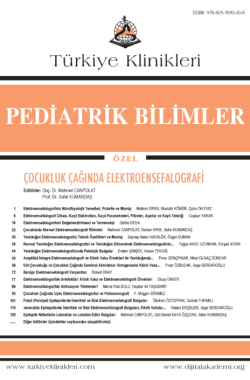Electroencephalography in Intensive Care and Electroencephalography in Diagnosis of Brain Death: Clinical Case Reports
Dilşad TÜRKDOĞANa
aÇocuk Nörolojisi BD, Marmara Üniversitesi Tıp Fakültesi, İstanbul, TÜRKİYE
Türkdoğan D. Yoğun bakım hastalarında elektroensefalografi kullanımı ve beyin ölümü tanısında elektroensefalografinin yeri ve klinik vaka örnekleri. Canpolat M, Kumandaş S, editörler. Çocukluk Çağında Elektroensefalografi. 1. Baskı. Ankara: Türkiye Klinikleri; 2019. p.163-72.
ABSTRACT
Continous EEG monitoring in intensive care units is a unique method for evaluation of coma. Because EEG demonstrates a high sensitivity to alterations of cerebral function, it is very useful for diagnosis, follow-up and evaluation of therapy of various coma etiologies. EEG is especially a convenient method for the follow-up of hypoxic-ischemic destruction, seizures and effects of drugs.
Keywords: Intensive care unit; continuous Electroencephalography monitoring; coma; encephalopathy; nonconvulsive seizures
Kaynak Göster
Referanslar
- Ebersole SJ, Husain AM, Nordli R. Continuous EEG monitoring in the intensive care unit. Current Practice of Clinic Electroencephalography. 4th ed. Wolters Kluwer; 2014. p.543-98.
- Jordan KG. Continuous EEG and evoked potential monitoring in the neurosciensce intensive care unit. J Clin Neurophysiol. 1993;10(4):445-75. [Crossref] [PubMed]
- Vespa PM, O'Phelan K, Shah M, Mirabelli J, Starkman S, Kidwell C, et al. Acute seizures after intracerebral hemorrhage: a factor in progressive midline shift and outcome. Neurology. 2003;60(9): 1441-6. [Crossref] [PubMed]
- Miller JD, Piper IR, Jones PA. Integrated multimodality monitoring in the neurosurgical intensive care unit. Neurosurg Clin N Am. 1994;5(4):661-70. [Crossref] [PubMed]
- Kane N, Acharya J, Benickzy S, Caboclo L, Finnigan S, Kaplan PW, et al. A revised glossary of terms most commonly used by clinical electroencephalographers and updated proposal for the report format of the EEG findings. Revision 2017. Clin Neurophysiol Pract. 2017;2:170-85. [Crossref] [PubMed] [PMC]
- Waterhouse E. Generalized encephalopathy. In: Ebersole SJ, Husain AM, Nordli R, eds. Current Practice of Clinic Electroencephalography. 4th ed. Wolters Kluwer; 2014. p.213-37.
- Nogueira de Melo A, Krauss GL, Niedermeyer E. Spindle coma: observations and thoughts. Clin Electroencephalogr. 1990;21(3):151-87. [Crossref] [PubMed]
- Brenner RP. The interpretation of the EEG in sputor and coma. Neurologist. 2005;11(5):271-84. [Crossref] [PubMed]
- Foley JM, Watson CW, Adams RD. Significance of the electroencephalography in hepatic coma. Trans Am Neurol Assoc. 1950;75:161-5.
- Trinka E, Leitinger M. Which EEG patterns in coma are nonconvulsive status epilepticus? Epilep Behav. 2015;49:203-22. [Crossref] [PubMed]
- Leitinger M, Trinka E, Gardella E, Rohracher A, Kalss G, Qerama E, et al. Diagnostic accuracy of the Salzburg EEG criteria for non-convulsive status epilepticus: a retrospective study. Lancet Neurol. 2016;15(10):1054-62. [Crossref] [PubMed]
- Nakagawa TA, Ashwal S, Mathur M, Mysore M; Society of Critical Care Medicine, Section on Critical Care and Section on Neurology of American Academy of Pediatrics; Child Neurology Society. Clinical report--guidelines for the determination of brain death in infants and children: an update of the 1987 task force recommendations. Pediatrics. 2011;128(3): e720-40. [Crossref] [PubMed]
- American Clinical Neurophysiology Society Guideline 3: Minimum Technical Standards for EEG Recording in Suspected Cerebral Death. American Clinical Neurophysiology; 2006. p.8. [Link]

